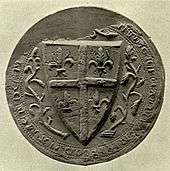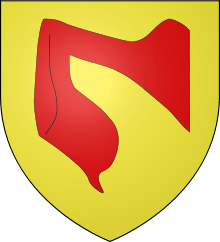John Hastings, 1st Baron Hastings


John Hastings, 1st Baron Hastings (6 May 1262 – 28 February 1313) was an English peer and soldier of the Middle Ages. Hastings was a competitor for the Scottish throne in 1290/92 in the Great Cause.
Baron
Hastings was the son of Henry de Hastings, who was summoned to Parliament by Simon de Montfort, 6th Earl of Leicester as Lord Hastings in 1263. However, this creation was not recognized by the King Henry III of England although John Hastings is sometimes referred to as the second Baron Hastings. His mother was Joanna de Cantilupe, sister and heiress of his uncle George de Cantilupe (d.1273).
He became the 13th Baron Bergavenny by tenure on the death of his uncle George de Cantilupe in 1273, and thereby acquired Abergavenny Castle and the honour of Abergavenny.
Soldier
Hastings fought from the 1290s in the Scottish, Irish and French wars of King Edward I and was later Seneschal of Aquitaine.
In 1290 he had unsuccessfully contested the Scottish crown as grandson of Ada, third daughter of David of Scotland, Earl of Huntingdon, who was a grandson of King David I. The same year he was summoned to the English Parliament as Lord Hastings.[2]
In 1301, he signed a letter to Pope Boniface VIII, protesting against papal interference in Scottish affairs.
Family and succession
Lord Hastings married as his first wife Isabel de Valence, daughter of William de Valence, 1st Earl of Pembroke and had the following children:
- William Hastings (1282–1311)
- John Hastings, 2nd Baron Hastings (29 September 1286 – 20 January 1325), married to Juliane de Leybourne (died 1367). They had a son:
- Lawrence who later became earl of Pembroke.
- Edmund, who was summoned to Parliament as Lord Hastings in 1299.
- Elizabeth who married Sir Roger de Grey, 1st Lord Grey (of Ruthin).[3]
He married second Isabel le Despenser, daughter of Hugh le Despenser and Isabella de Beauchamp. They had the following children:
- Thomas de Hastings
- Margaret de Hastings
- Sir Hugh Hastings of Sutton (died 1347), married Margery Foliot (granddaughter of Jordan Foliot and of William de Braose). Had issue.[4]
He died in February 1313, aged 50, and was succeeded in the Barony by his eldest son John.
| Peerage of the United Kingdom | ||
|---|---|---|
| Preceded by New Creation |
Baron Hastings 1290–1313 |
Succeeded by John Hastings |
Notes
- ↑ http://www.briantimms.net/era/collins/collins02/Collins02.htm
- ↑ “He … is recorded to have been present in pleno parliamento domini Regis on the morrow of Trinity 18 Edw. I [29 May 1290] with other magnates et proceres tunc in parliamento existentes, whereby he is held to have become LORD HASTINGES….In the Hastings Peerage claim in 1840-41 the Committee for Privileges of the House of Lords, following the recommendation of Lord Chancellor Cottenham, decided that the presence of Sir John de Hastings in this Parliament was pursuant to the issue of a writ of summons to him, and resolved accordingly.” - The Complete Peerage, 2nd edition, Volume VI, P 347
- ↑ Lundy, Darryl. "p. 4051 § 40502". The Peerage.
- ↑ Richardson, D. (2011) Magna Carta Ancestry 2nd Edition, pg 325 (via Google)
References
- Kidd, Charles, Williamson, David (editors). Debrett's Peerage and Baronetage (1990 edition). New York: St Martin's Press, 1990,
- Leigh Rayment's Peerage Pages